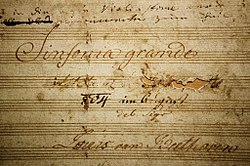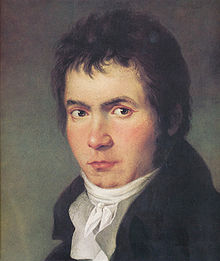| Mp3s Biography Sheetmusic | Ludwig van Beethoven opus 55Symphony No. 3 "Eroica"Symphony in E flat minor. 1803. Time: 47'30. |
| Buy sheetmusic for this work at SheetMusicPlus |
|
The Symphony No. 3 in E flat major (Op. 55) by Ludwig van Beethoven, known as the Eroica (Italian for "heroic") is a landmark musical work. It marks the full arrival in Beethoven's symphonic output of his characteristic middle-period "heroic style", a style heralded in the earlier theatre work Creatures of Prometheus and also apparent in his opera Fidelio. The symphony is widely regarded as a mature expression of the classical style of the late eighteenth century that also exhibits defining features of the romantic style that would hold sway in the nineteenth century.
InstrumentationThe symphony is scored for 2 flutes, 2 oboes, 2 clarinets in B flat, 2 bassoons, 3 horns in E flat,2 trumpets in E flat and C, timpani in E flat and B flat and strings. StructureThe piece is in four movements:
OverviewDedication and premiereBeethoven had originally conceived of dedicating the symphony to Napoleon Bonaparte. The biographer Maynard Solomon relates that Beethoven admired the ideals of the French Revolution, and Napoleon as their embodiment. In the autumn the composer began to have second thoughts about that dedication. It would have deprived him of a fee that he would receive if he instead dedicated the symphony to Prince Franz Joseph Maximillian Lobkowitz. Nevertheless, he still gave the work the title of Bonaparte. When Napoleon proclaimed himself Emperor of the French in May 1804, Beethoven became disgusted and went to the table where the completed score lay. He took hold of the title-page and scratched the name Bonaparte out so violently with a knife that he created a hole in the paper.[1] He later changed the title to Sinfonia eroica, composta per festeggiare il sovvenire d'un grand'uomo ("heroic symphony, composed to celebrate the memory of a great man"). His assistant Ferdinand Ries tells the story in his biography of Beethoven:
However, the road to titling of the work Eroica had further turns. After completing the work, Beethoven wrote to his publisher in the summer of 1804 that "The title of the symphony is really Bonaparte." The final title was not applied to the work until the parts were published in October, 1806. In fact, Schindler tells us that upon hearing of the Emperor's death in Saint Helena in 1821, Beethoven proclaimed "I wrote the music for this sad event seventeen years ago" - referring to the Funeral March (second movement). Beethoven wrote most of the symphony in late 1803 and completed it in early 1804. The symphony was premiered privately in summer 1804 in his patron Prince Lobkowitz's castle Eisenberg (Jezeri) in Bohemia. The first public performance was given in Vienna's Theater an der Wien on April 7, 1805 with the composer conducting. For that performance, the work's key was announced as "Dis", the German for D-sharp.[3] Musical characteristics and uniquenessThe work is a milestone in the history of the classical symphony for a number of reasons. The piece is about twice as long as symphonies by Haydn or Mozart—the first movement alone is almost as long as many Classical symphonies, if the expositional repeat is observed. The work covers more emotional ground than earlier works had, and is often cited as the beginning of the Romantic period in music.[4] The second movement, in particular, displays a great range of emotion, from the misery of the main funeral march theme, to the relative solace of happier, major key episodes. The finale of the symphony shows a similar range, and is given an importance in the overall scheme which was virtually unheard of previously [5] —whereas in earlier symphonies, the finale was a quick and breezy finishing off, here it is a lengthy set of variations and fugue on a theme Beethoven had originally written for his ballet music The Creatures of Prometheus. The Eroica set classical music on a new course. Thenceforth, the composer was no longer beholden to a musical structure, to tradition, or to the tastes of the audience but became the master of his own creation. Human aspirations, fears, and passions would become central to the creation of music. Thus, if ever there was a single work that changed the course of classical music history, this was it. ReceptionAccording to Harold C. Schonberg, “Musical Vienna was divided on the merits of the Eroica. Some called it Beethoven’s masterpiece. Others said that the work merely illustrated a striving for originality that did not come off.” [6] A Symphony in E flat major by the now-forgotten Anton Eberl (1765-1807) was premiered at the same concert, and it received rather more positive reviews than Beethoven's did.[3] Music critic J. W. N. Sullivan writes[7] that the first movement is an expression of Beethoven's courage in confronting his deafness, the second, slow and dirgelike, depicting the overwhelming despair he felt, the third, the scherzo, an "indomitable uprising of creative energy" and the fourth an exuberant outpouring of creative energy. Hector Berlioz discussed Beethoven’s use of the horn and the oboe in his Treatise on Orchestration. Writers on art from the Marxist tradition often seize on the Eroica. Gareth Jenkins wrote that "Beethoven was doing for music what Napoleon was doing for society—turning tradition upside down", and that the symphony embodied a "sense of human potential and freedom" first seen in the period of the French Revolution.[8] Richard Strauss's mourning music Metamorphosen is based on the theme of the funeral march from the Eroica, and combines harmonically distorted variants of its main motifs. At the very end the opening bars of the funeral march are quoted literally in the bass. Horn solo anecdoteIn the first movement, the solo horn enters with the main theme four bars before the "real" recapitulation. Beethoven's disciple Ferdinand Ries recounted:[9]
Use of second movement in funerals
Eroica on screenIn 2003 a Simon Cellan Jones-directed BBC / Opus Arte made-for-television film, Eroica, was released, with Ian Hart as Beethoven. The Orchestre Révolutionnaire et Romantique, conducted by Sir John Eliot Gardiner, performs the Eroica Symphony in its entirety. The subject of the film is the private 1804 premiere of the Eroica Symphony at the palace of Prince Lobkowitz (played by Jack Davenport). The film is based in part on Ferdinand Ries' recollections of the event. [13] In the film Beethoven does not learn that Napoleon has crowned himself Emperor of France until after the performance of the symphony is over - while having dinner with Ferdinand Ries. Rather than tearing up the title page of the symphony, he simply crumples it up. In 1994, portions of the Eroica were used in the biographical film, Immortal Beloved starring Gary Oldman as Beethoven. Written and directed by Bernard Rose, the film's score uses various works of Beethoven that were selected by the film's music director, Sir Georg Solti. Notes
References
External links
| |||||||||||||
This article is licensed under the GNU Free Documentation License. It uses material from the Wikipedia article "Symphony_No._3_(Beethoven)". Allthough most Wikipedia articles provide accurate information accuracy can not be guaranteed. | |||||||||||||
Help us with donations or by making music available!
©2023 Classic Cat - the classical music directory

Beethoven, L. van
Symphony No. 1 in C major
Vienna Philharmonic
Beethoven, L. van
Piano Sonata No. 29 "Hammerklavier"
Paavali Jumppanen
Beethoven, L. van
Piano Sonata No. 14 "Moonlight"
Sandro Bisotti
Beethoven, L. van
String Quartet No. 9 "Rasumowsky-Quartett" #3
Végh Quartet
Beethoven, L. van
25 Scottish songs
Elio Battaglia
Beethoven, L. van
Piano Sonata No. 1 in F minor
Mark Hensley


